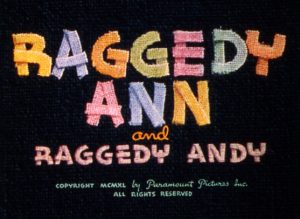 The Fleischers must have had the idea that they could restore their relationship with Paramount by putting out occasional extended specials in Technicolor. Having run the gamut on Arabian Nights tales with Popeye, they decided to turn their attention to new characters and storylines. So they went with something more recent – Johnny Gruelle’s popular “Raggedy Ann” character, and in a different direction created a modern-day parody upon a popular work from one of America’s first noted poets, Edgar Allen Poe. All the while, they were still working on Mr. Bug Goes To Town, which left the creative powers of the studio well-divided, and would ultimately prove an unfortunate project for them, the victim of bad timing and studio politics, leading to the studio’s demise.
The Fleischers must have had the idea that they could restore their relationship with Paramount by putting out occasional extended specials in Technicolor. Having run the gamut on Arabian Nights tales with Popeye, they decided to turn their attention to new characters and storylines. So they went with something more recent – Johnny Gruelle’s popular “Raggedy Ann” character, and in a different direction created a modern-day parody upon a popular work from one of America’s first noted poets, Edgar Allen Poe. All the while, they were still working on Mr. Bug Goes To Town, which left the creative powers of the studio well-divided, and would ultimately prove an unfortunate project for them, the victim of bad timing and studio politics, leading to the studio’s demise.
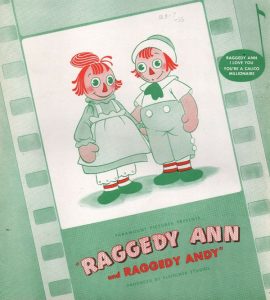 Raggedy Ann and Raggedy Andy (4/11/41) – A full-fledged musical treatment of the Gruelle characters, set within the wraparound tale of a toy shop owner, who tries to explain why he cannot sell separately the two dolls, whose hands are stitched together. Perhaps the most affectingly cute cartoon from the studio since Somewhere In Dreamland, though not as overt at the tugging of the heartstrings. Ann and Andy are portrayed here as sweethearts, rather than as brother and sister as they were in Gruelle’s original story. They decide to make the long and arduous journey from the doll manufacturing factory to the Castle of Names, to find out who they are. But Andy is tempted and side-tracked by a Senorita doll, somewhat inspired by Carmen Miranda, and dallies from reaching his appointed rounds by nightfall. Ann carries on alone, but falls sick of a broken heart. She rests critically ill at the Castle, on the verge of expiring. Meanwhile Andy finds himself in the disrespect of the Senorita when he reveals he is nameless, the Senorita insisting he is nobody without a name. Andy races for the castle, arriving just in time before sundown to receive his name certificate, and also to pick up Ann’s too. His reunion in song with Ann on her sickbed mends Ann’s broken heart, and the two enter into a permanent union (the doll equivalent of marriage) by exchanging vows and having their hands stitched permanently together with a sewing machine. The scene returns to the toy shop in the present day, where a little girl, disappointed that she only has money for one doll and not two, leaves the store dejected – until the shopkeeper states that, just because he can’t sell just one doll, doesn’t mean he can’t give a gift of both. The girl leaves happily with her pair of new toys, who seem to exchange happy glances between each other for the fade out. Songs: Mostly original numbers written by Sammy Timberg, with Dave Fleischer credited as co-writer. The one exception is “I’ve Got a Pain In My Sawdust”, which was actually an old song, recorded in the teens by Kitty Cheatham on Columbia in 1910 and later on Victor blue seal. Mae Questel would record it for Decca in the 1930’s – but this will be matter for a special supplement which we will see in this column shortly. Tiny Tim would revive the number in 1962. The original songs of the film include “Raggedy Ann, I Love You”, “You’re a Calico Millionaire”, “We No Speak Americano”, and “You’re Nobody Without a Name”.
Raggedy Ann and Raggedy Andy (4/11/41) – A full-fledged musical treatment of the Gruelle characters, set within the wraparound tale of a toy shop owner, who tries to explain why he cannot sell separately the two dolls, whose hands are stitched together. Perhaps the most affectingly cute cartoon from the studio since Somewhere In Dreamland, though not as overt at the tugging of the heartstrings. Ann and Andy are portrayed here as sweethearts, rather than as brother and sister as they were in Gruelle’s original story. They decide to make the long and arduous journey from the doll manufacturing factory to the Castle of Names, to find out who they are. But Andy is tempted and side-tracked by a Senorita doll, somewhat inspired by Carmen Miranda, and dallies from reaching his appointed rounds by nightfall. Ann carries on alone, but falls sick of a broken heart. She rests critically ill at the Castle, on the verge of expiring. Meanwhile Andy finds himself in the disrespect of the Senorita when he reveals he is nameless, the Senorita insisting he is nobody without a name. Andy races for the castle, arriving just in time before sundown to receive his name certificate, and also to pick up Ann’s too. His reunion in song with Ann on her sickbed mends Ann’s broken heart, and the two enter into a permanent union (the doll equivalent of marriage) by exchanging vows and having their hands stitched permanently together with a sewing machine. The scene returns to the toy shop in the present day, where a little girl, disappointed that she only has money for one doll and not two, leaves the store dejected – until the shopkeeper states that, just because he can’t sell just one doll, doesn’t mean he can’t give a gift of both. The girl leaves happily with her pair of new toys, who seem to exchange happy glances between each other for the fade out. Songs: Mostly original numbers written by Sammy Timberg, with Dave Fleischer credited as co-writer. The one exception is “I’ve Got a Pain In My Sawdust”, which was actually an old song, recorded in the teens by Kitty Cheatham on Columbia in 1910 and later on Victor blue seal. Mae Questel would record it for Decca in the 1930’s – but this will be matter for a special supplement which we will see in this column shortly. Tiny Tim would revive the number in 1962. The original songs of the film include “Raggedy Ann, I Love You”, “You’re a Calico Millionaire”, “We No Speak Americano”, and “You’re Nobody Without a Name”.
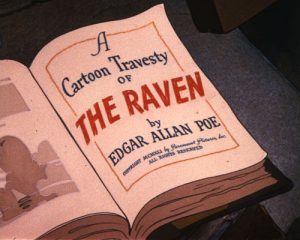 A Cartoon Travesty of the Raven (4/3/42) – The shortest of the two-reel specials, each reel being only about seven minutes long. A modern-day setting finds the Raven knocking on chamber doors – bit with a new intention – to act as door-to-door salesman of vacuum cleaners. His knocking turns out to be upon the abode of an old acquaintance – a wolf with a penchant for larceny. The wolf suspects the Raven of being in a new “racket”, but the Raven insists he has turned honest and gone straight, and is merely trying to fill his quota on vacuum sales. The wolf decides to “help” him meet his quota, by directing him to an old mansion where a tight-fisted Scotch Terrier resides, telling the Raven “The joint hasn’t been cleaned out in years”. The two are turned away at the mansion door by a variety of gunfire and booby traps, until the wolf drops a dime on the front step, knowing its clink will bring the money-loving Scotsman running to the door. A musical sales pitch is engaged in by our selling two, while the Scotsman expresses preference for his bagpipes as a means of blowing the dirt away. While the Raven keeps at his touting of the virtues of the vacuum, the wolf cases the place, and labors to open a giant safe – which proves to be “nested” with smaller, smaller, and even smaller safes within. The vacuum meanwhile gets into a cache of vintage Scotch in the Scottie’s basement, and becomes entirely inebriated and haywire. It runs amok, but eventually foils the wolf’s efforts to make off with the contents of the safe, and even sucks away the wolf’s outer garments, revealing him to still be clothed in prison underwear underneath, just in time to be seen by a passing patrol of motorcycle policemen. The grateful Scotsman purchases the vacuum at last, while the Raven exchanges words with the film’s narrator that he has no idea why he is known for saying “Nevermore”. “I’m sorry, I don’t know it. That was thought up by the poet.”
A Cartoon Travesty of the Raven (4/3/42) – The shortest of the two-reel specials, each reel being only about seven minutes long. A modern-day setting finds the Raven knocking on chamber doors – bit with a new intention – to act as door-to-door salesman of vacuum cleaners. His knocking turns out to be upon the abode of an old acquaintance – a wolf with a penchant for larceny. The wolf suspects the Raven of being in a new “racket”, but the Raven insists he has turned honest and gone straight, and is merely trying to fill his quota on vacuum sales. The wolf decides to “help” him meet his quota, by directing him to an old mansion where a tight-fisted Scotch Terrier resides, telling the Raven “The joint hasn’t been cleaned out in years”. The two are turned away at the mansion door by a variety of gunfire and booby traps, until the wolf drops a dime on the front step, knowing its clink will bring the money-loving Scotsman running to the door. A musical sales pitch is engaged in by our selling two, while the Scotsman expresses preference for his bagpipes as a means of blowing the dirt away. While the Raven keeps at his touting of the virtues of the vacuum, the wolf cases the place, and labors to open a giant safe – which proves to be “nested” with smaller, smaller, and even smaller safes within. The vacuum meanwhile gets into a cache of vintage Scotch in the Scottie’s basement, and becomes entirely inebriated and haywire. It runs amok, but eventually foils the wolf’s efforts to make off with the contents of the safe, and even sucks away the wolf’s outer garments, revealing him to still be clothed in prison underwear underneath, just in time to be seen by a passing patrol of motorcycle policemen. The grateful Scotsman purchases the vacuum at last, while the Raven exchanges words with the film’s narrator that he has no idea why he is known for saying “Nevermore”. “I’m sorry, I don’t know it. That was thought up by the poet.”
The score is largely split between variations on two musical works, Liszt’s durable “Second Hungarian Rhapsody”, and “The Campbells are Coming”. One of the earliest recordings I’ve located of the latter is a version on Columbia, anonymously performed by “Fife and Drum Corps”. Tommy Dandurand and his Barn Dance Fiddlers recorded an early electric hillbilly version on Electrobeam Gennett, also appearing on Champion, Silvertone, and Challenge (the latter two labels made exclusively for Sears and Roebuck, under the pseudonym “George Kline”). An early 40’s version appears on Bluebird by Cecil Campbell and his Tennessee Ramblers.
Upon the close of the Fleischer Studios, and the abandonment of further feature projects and two-reelers, the regrouping principal animators, now under the new banner of “Famous Studios”, would again find themselves in search of a series to fill out their distribution schedule beyond the usual quota of Popeyes and periodic new episodes of Superman on a slightly more limited budget. By now, a sense of competition must have been keen, as George Pal had arrived in America, bringing with him his stop-motion art under the series banner of “Madcap Models”. Quite quickly, the Pal product stole the prestige from Paramount’s own animation team, racking up critical acclaim and a string of Oscar nominations. While the makings of some recurring characters were percolating in the directors’ minds, no one character as yet seemed a strong-enough bet for the launching of a new series in his own right, So the studio compromised with the concept of the “Noveltoon” – an all-Technicolor (or eventually Cinecolor and Polacolor when Technicolor processing became more expensive and backlogged) series that would include one-shots (some developed from literary works) as well as recurring characters such as Blackie the black sheep, mongrel Dog Face, and Herman the Mouse, With the studio’s manpower now concentrated back on the short subjects (where they belonged), results improved markedly, with sharper gag writing, stronger personalities, and well-placed voice casting, recruiting the New York talent of Arnold Stang, Sid Raymond, and Jackson Beck, together with the return of Mae Questel. Unlike the Animated Antics, the format would attain reasonable success, and the series banner would continue to be used until nearly the end of the studio’s production history
 Cilly Goose (3/24/44) – A retelling of the Goose that Laid the Golden Eggs – with a modern twist. Cilly can’t get attention from any of her co-residents of the barnyard about laying her first egg – they all being occupied with their own large families – until she decides to paint the egg gold. Cilly suddenly becomes front-page news, hob-nobbing in the circles of caricatures of Walter Winchell and Fiorella La Guardia. Somehow, she gets booked to publicly lay a golden egg in Madison Square Garden – a task which she comes to realize will debunk her fraudulent story. However, when she reaches the climactic moment in the center arena, closing her eyes and awaiting the worst, the egg she lays is really solid gold! Inspired, she begins laying gold eggs non-stop – by the crateload – which results in a mass riot, first to claim her eggs, then to capture her. As she is about to face impending doom, she awakens to find it was a dream inspired by a fairy-tale book. Her real egg hatches, producing a normal gosling – with the exception of a prominent gold tooth. Songs: “Rock-a-Bye-Baby”, “William Tell Overture- The Chase”, “Thanks For the Memory” (as Cilly reads “How To Lay an Egg” (by Bob Hope), and an unidentified conga number, during Cilly’s egg laying frenzy in the arena.
Cilly Goose (3/24/44) – A retelling of the Goose that Laid the Golden Eggs – with a modern twist. Cilly can’t get attention from any of her co-residents of the barnyard about laying her first egg – they all being occupied with their own large families – until she decides to paint the egg gold. Cilly suddenly becomes front-page news, hob-nobbing in the circles of caricatures of Walter Winchell and Fiorella La Guardia. Somehow, she gets booked to publicly lay a golden egg in Madison Square Garden – a task which she comes to realize will debunk her fraudulent story. However, when she reaches the climactic moment in the center arena, closing her eyes and awaiting the worst, the egg she lays is really solid gold! Inspired, she begins laying gold eggs non-stop – by the crateload – which results in a mass riot, first to claim her eggs, then to capture her. As she is about to face impending doom, she awakens to find it was a dream inspired by a fairy-tale book. Her real egg hatches, producing a normal gosling – with the exception of a prominent gold tooth. Songs: “Rock-a-Bye-Baby”, “William Tell Overture- The Chase”, “Thanks For the Memory” (as Cilly reads “How To Lay an Egg” (by Bob Hope), and an unidentified conga number, during Cilly’s egg laying frenzy in the arena.
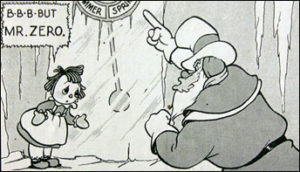 Suddenly It’s Spring (4/26/44) – The first return for Raggedy Ann to the studio, somehow minus her sewn partner Andy. Her owner, a little girl, is seriously ill, and needs sunshine – in the midst of a cold winter. Ann is directed by a toy kite to the Sun, ruled over by a kindly king, who is more than willing to provide the needed light, if she can find a way to get the clouds to move aside. The cloud (depicted as a stereotypical Stepin Fetchit type), is unable (or unwilling?) to move a muscle to let the sun through, unless pushed by a breeze. The breeze says it’s honor-bound not to blow until directed by Zero, the hard-hearted King of winter. The old coot of a monarch scoffs at the thought of giving up his hold on the Winter season early, until Raggedy Ann slowly warms his disposition with an original song, “The World Is Longing For the Sunshine”. The miracle of an early Spring is accomplished, as Ann, (of course immobile before the eyes of the humans) smiles silently among the toys at her accomplishment in making her owner well. This film did not use the song of the same title as the picture, a number owned by Famous Music and penned by Johnny Burke and James Van Husen, composed for the film version of “Lady In The Dark”, and recorded on Decca in versions by Glen Gray and Hildegarde. The cartoon would leave behind a bit of a legacy (possibly due to the unlikelihood of its reissue in the 1950’s by reason of its black stereotype), as the basis for a reworking of the second half of the cartoon in the Little Audrey series as Audrey the Rainmaker.
Suddenly It’s Spring (4/26/44) – The first return for Raggedy Ann to the studio, somehow minus her sewn partner Andy. Her owner, a little girl, is seriously ill, and needs sunshine – in the midst of a cold winter. Ann is directed by a toy kite to the Sun, ruled over by a kindly king, who is more than willing to provide the needed light, if she can find a way to get the clouds to move aside. The cloud (depicted as a stereotypical Stepin Fetchit type), is unable (or unwilling?) to move a muscle to let the sun through, unless pushed by a breeze. The breeze says it’s honor-bound not to blow until directed by Zero, the hard-hearted King of winter. The old coot of a monarch scoffs at the thought of giving up his hold on the Winter season early, until Raggedy Ann slowly warms his disposition with an original song, “The World Is Longing For the Sunshine”. The miracle of an early Spring is accomplished, as Ann, (of course immobile before the eyes of the humans) smiles silently among the toys at her accomplishment in making her owner well. This film did not use the song of the same title as the picture, a number owned by Famous Music and penned by Johnny Burke and James Van Husen, composed for the film version of “Lady In The Dark”, and recorded on Decca in versions by Glen Gray and Hildegarde. The cartoon would leave behind a bit of a legacy (possibly due to the unlikelihood of its reissue in the 1950’s by reason of its black stereotype), as the basis for a reworking of the second half of the cartoon in the Little Audrey series as Audrey the Rainmaker.
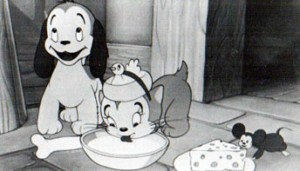 Gabriel Churchkitten (12/15/44), Based on a children’s book of the same name. A churchmouse and the title character are up late at night, hoping that the somnambulist parson of the chu.ch will remember to feed them. The parson proceeds to sleepwalk over to the cupboard, pulls out some cheese for the cat and milk for the mouse – then eats them himself – and wonders in the morning why he’s not hungry. They eventually do wake the parson up with the help of a howling hound pup from next door named “Trumpet”, whom Gabriel, remembering an old passage from the sermons, “blows on” in the pip’s ear to sound a wake-up call. Songs: “The Church In the Wildwood”, written by Dr. William H. Pitt in 1857. The Chautauqua Preachers’ Quartette performed one of the earliest versions on Columbia circa 1915, and also another version on Pathe Actuelle. The Jenkins Family recorded a country version for acoustic Okeh. The Criterion Quartette recorded it for Brunswick. The Tietge Sisters issued a Victor scroll version in the late 1920’s. The Carter Family performed an electrical for Bluebird. The Chuck Wagon Gang also sang it for Meloteone and Perfect in 1936.
Gabriel Churchkitten (12/15/44), Based on a children’s book of the same name. A churchmouse and the title character are up late at night, hoping that the somnambulist parson of the chu.ch will remember to feed them. The parson proceeds to sleepwalk over to the cupboard, pulls out some cheese for the cat and milk for the mouse – then eats them himself – and wonders in the morning why he’s not hungry. They eventually do wake the parson up with the help of a howling hound pup from next door named “Trumpet”, whom Gabriel, remembering an old passage from the sermons, “blows on” in the pip’s ear to sound a wake-up call. Songs: “The Church In the Wildwood”, written by Dr. William H. Pitt in 1857. The Chautauqua Preachers’ Quartette performed one of the earliest versions on Columbia circa 1915, and also another version on Pathe Actuelle. The Jenkins Family recorded a country version for acoustic Okeh. The Criterion Quartette recorded it for Brunswick. The Tietge Sisters issued a Victor scroll version in the late 1920’s. The Carter Family performed an electrical for Bluebird. The Chuck Wagon Gang also sang it for Meloteone and Perfect in 1936.
 When G.I. Johnny Comes Home (2/2/45) – No plot to speak of, but a lot of gags on what the demobilized soldiers will do on their return to the USA. The cartoon successfully predicts the baby boom that was to follow (though failing to predict that not all the boys would come home at the same time, many having to serve as occupation troops). “When Johnny Comes Marching Home” is the primary song, presented with some new special lyrics in a return to the follow-the-bouncing-ball sing along format (which probably took audiences, unwarned by any banner announcing this to be a return to the Screen Song, by surprise after many years of absence of such shorts from the screen). The song was written by Patrick Gilmore in 1862. Gilmore was still known for military music composing in the 1890’s, and actually got a chance to conduct some recordings. An 1898 recording by an unknown vocalist was released on Berliner. Harry Marlow recorded a version tailored for Britain and WWI on Regal, as “When Tommy Comes Marching Home”. Amparito Ferrar recorded it on Columbia Grand Award. Paul Althouse performed a vertical-cut version on Pathe (issued with a cream-colored label as part of their classical series). The Andrews Sisters souped it up for swing on a 1940’s Decca side. Glenn Miller recorded it for Victor, Carl Hoff covered it on Okeh. It would also receive various coverage on albums as well as become a children’s staple around the time of the Civil War centennial, including a Little Golden Records version by Win Stracke.
When G.I. Johnny Comes Home (2/2/45) – No plot to speak of, but a lot of gags on what the demobilized soldiers will do on their return to the USA. The cartoon successfully predicts the baby boom that was to follow (though failing to predict that not all the boys would come home at the same time, many having to serve as occupation troops). “When Johnny Comes Marching Home” is the primary song, presented with some new special lyrics in a return to the follow-the-bouncing-ball sing along format (which probably took audiences, unwarned by any banner announcing this to be a return to the Screen Song, by surprise after many years of absence of such shorts from the screen). The song was written by Patrick Gilmore in 1862. Gilmore was still known for military music composing in the 1890’s, and actually got a chance to conduct some recordings. An 1898 recording by an unknown vocalist was released on Berliner. Harry Marlow recorded a version tailored for Britain and WWI on Regal, as “When Tommy Comes Marching Home”. Amparito Ferrar recorded it on Columbia Grand Award. Paul Althouse performed a vertical-cut version on Pathe (issued with a cream-colored label as part of their classical series). The Andrews Sisters souped it up for swing on a 1940’s Decca side. Glenn Miller recorded it for Victor, Carl Hoff covered it on Okeh. It would also receive various coverage on albums as well as become a children’s staple around the time of the Civil War centennial, including a Little Golden Records version by Win Stracke.
 The Friendly Ghost (11/15/45) – Casper is unlike the other ghosts he is residing with (notice I didn’t say “living”). While the other ghosts all look forward to their nightly chance to scare the city folk, Casper is busy reading “How to Win Friends” – thus the initial premises of the series yet to come were already being established. The cartoon even foreshadows one of the lines in the future Casper thee song: “Grown-ups don’t understand why children love him the most”. While the other ghosts go out on what would later be called a “scare raid”. Casper packs a bindle stick and goes out into the world to try to make friends. After each attempt fails in the usual fashion, Casper becomes so despondent that he trues to end it all by sitting on a railroad track – forgetting he is already dead, so how can a ghost commit suicide? – as the train speeds right through him. Casper is, however, surprised to meet a young boy and girl playing near the tracks, who are not afraid if him, and invite him to join their games. He is escorted by them to their home, but their mother is not so understanding, and orders the little ghost out of the house. But when a landlord comes to collect the mortgage, his reaction is quite standard. “A ghost! The house is haunted. Keep the mortgage!”. As he runs for the hills, Mom accepts the little ghost for his valuable good deed, and Casper is adopted as one of the family, accompanying the kids in human attire for his first day of school at the closing. Songs: “ Chicken Reel”, “In and Out the Window”, and the “Alphabet Song” (aka “I Don’t Know My A,B,C” aka “Twinkle, Twinkle, Little Star”). This time, instead of an embed… here’s the studio cue sheet:
The Friendly Ghost (11/15/45) – Casper is unlike the other ghosts he is residing with (notice I didn’t say “living”). While the other ghosts all look forward to their nightly chance to scare the city folk, Casper is busy reading “How to Win Friends” – thus the initial premises of the series yet to come were already being established. The cartoon even foreshadows one of the lines in the future Casper thee song: “Grown-ups don’t understand why children love him the most”. While the other ghosts go out on what would later be called a “scare raid”. Casper packs a bindle stick and goes out into the world to try to make friends. After each attempt fails in the usual fashion, Casper becomes so despondent that he trues to end it all by sitting on a railroad track – forgetting he is already dead, so how can a ghost commit suicide? – as the train speeds right through him. Casper is, however, surprised to meet a young boy and girl playing near the tracks, who are not afraid if him, and invite him to join their games. He is escorted by them to their home, but their mother is not so understanding, and orders the little ghost out of the house. But when a landlord comes to collect the mortgage, his reaction is quite standard. “A ghost! The house is haunted. Keep the mortgage!”. As he runs for the hills, Mom accepts the little ghost for his valuable good deed, and Casper is adopted as one of the family, accompanying the kids in human attire for his first day of school at the closing. Songs: “ Chicken Reel”, “In and Out the Window”, and the “Alphabet Song” (aka “I Don’t Know My A,B,C” aka “Twinkle, Twinkle, Little Star”). This time, instead of an embed… here’s the studio cue sheet:
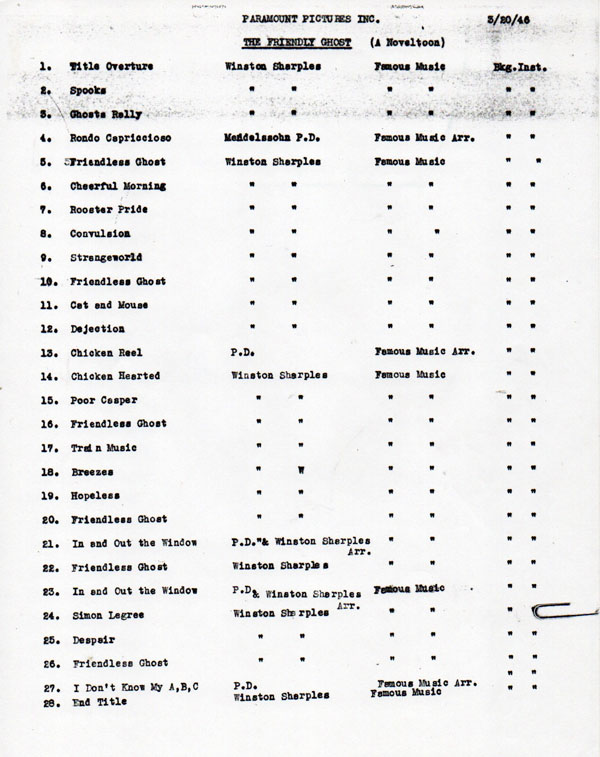
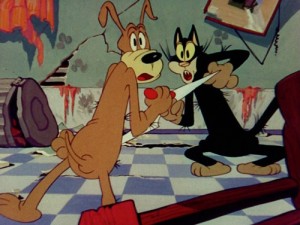 Cheese Burglar (2/22/46) – An early Herman solo, with some wild off-model animation by Jim Tyer. A cat and a dog are very good friends, and vocalize about it vociferously. Herman decides to do something about this – since dogs and cats are natural enemies – and since the two of them won’t let him raid the refrigerator. Herman supplies the two with whispers in their ear about how their “pal” is out to kill them, and then provides lethal weapons in the right places to frame each of them into looking like they are attempring murder upon each other. The ruse almost works, but the two get wise, and fake their own deaths to trap Herman, finally cornering him inside a wine bottle. To get him out, the dog and cat take generous swigs from the bottle – until they, and Herman inside, are totally inebriated. The film ends with all three repeating a drunken chorus of their “Pal” song, Herman now a part of a three-way friendship. The script would in essence be ripped-off entirely by Friz Freleng a few years later, in the Sylvester episode, “Stooge For a Mouse”. Songs: “Dear Old Pal”, an original by Winston Sharples (unknown if assisted by an uncredited lyricist), with vocals by Jackson Beck (dog), Jack Mercer (cat), and Arnold Stang (Herman).
Cheese Burglar (2/22/46) – An early Herman solo, with some wild off-model animation by Jim Tyer. A cat and a dog are very good friends, and vocalize about it vociferously. Herman decides to do something about this – since dogs and cats are natural enemies – and since the two of them won’t let him raid the refrigerator. Herman supplies the two with whispers in their ear about how their “pal” is out to kill them, and then provides lethal weapons in the right places to frame each of them into looking like they are attempring murder upon each other. The ruse almost works, but the two get wise, and fake their own deaths to trap Herman, finally cornering him inside a wine bottle. To get him out, the dog and cat take generous swigs from the bottle – until they, and Herman inside, are totally inebriated. The film ends with all three repeating a drunken chorus of their “Pal” song, Herman now a part of a three-way friendship. The script would in essence be ripped-off entirely by Friz Freleng a few years later, in the Sylvester episode, “Stooge For a Mouse”. Songs: “Dear Old Pal”, an original by Winston Sharples (unknown if assisted by an uncredited lyricist), with vocals by Jackson Beck (dog), Jack Mercer (cat), and Arnold Stang (Herman).
A special supplement next time: Betty Boop on records.


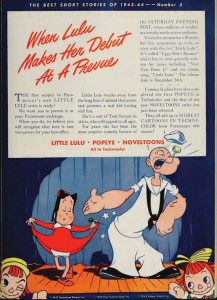
 James Parten has overcome a congenital visual disability to be acknowledged as an expert on the early history of recorded sound. He has a Broadcasting Certificate (Radio Option) from Los Angeles Valley College, class of 1999. He has also been a fan of animated cartoons since childhood.
James Parten has overcome a congenital visual disability to be acknowledged as an expert on the early history of recorded sound. He has a Broadcasting Certificate (Radio Option) from Los Angeles Valley College, class of 1999. He has also been a fan of animated cartoons since childhood.












































Bob Hope’s book “How to Lay an Egg”, seen in “Cilly Goose”, calls to mind a line that he used to say to the troops whenever one of his jokes bombed: “If I have to lay an egg for my country, I will!”
During the war years, composer Morton Gould used “When Johnny Comes Marching Home” as the basis for an overblown orchestral fantasia titled “American Salute”. It’s been recorded multiple times by the Boston Pops, among others, and it was played to death by every youth orchestra in America during the bicentennial year of 1976.
Casper also attempted suicide in his fourth cartoon, “Casper’s Spree Under the Sea”, when he tied himself to a rock and pushed it into the ocean. It turns out that ghosts can breathe underwater.
“The Raven” would have been funnier if it was only one reel and stuck closer to the original poem, with the raven driving his customer crazy by insisting on selling him that vacuum. The story as it is seems more like a digression from a main plot that they never get back to. Travesty, indeed.
If you want a good cartoon parody of The Raven, there’s Bullwinkle’s attempt at reciting it for his Poetry Corner, which is ruined when a woodpecker (not Woody) comes tapping at his chamber door instead; or the Tiny Toons version with Vincent Price himself as Poe and Sweetie Bird (Tiny Toons’ version of Tweety) in the raven’s place, acting more like an annoying neighbor; and then there’s the Simpsons version that ends the first “Treehouse of Horror” episode, with James Earl Jones reciting the poem straight and the Simpsons acting it out as best they can. (“Quoth the raven…” “Eat my shorts!”)
“The Raven” actually isn’t much longer than a one-reeler, and an unexceptional cartoon anyway, although it would be nice to see a first class Technicolor print of it. Ditto “The Friendly Ghost”; you’d think Casper’s debut film would warrant it.
“Suddenly It’s Spring,” with its elaborate characterizations of natural phenomena (God help me, but Cloudy’s cheekbones remind me of Barack Obama), anticipates the Rankin-Bass holiday specials. Raggedy Ann, flirtatiously singing “The World is Longing for the Sunshine” to Zero, is playing a dangerous game.